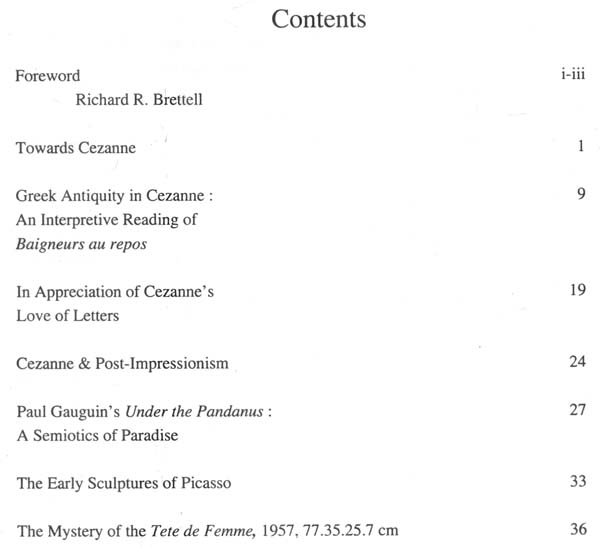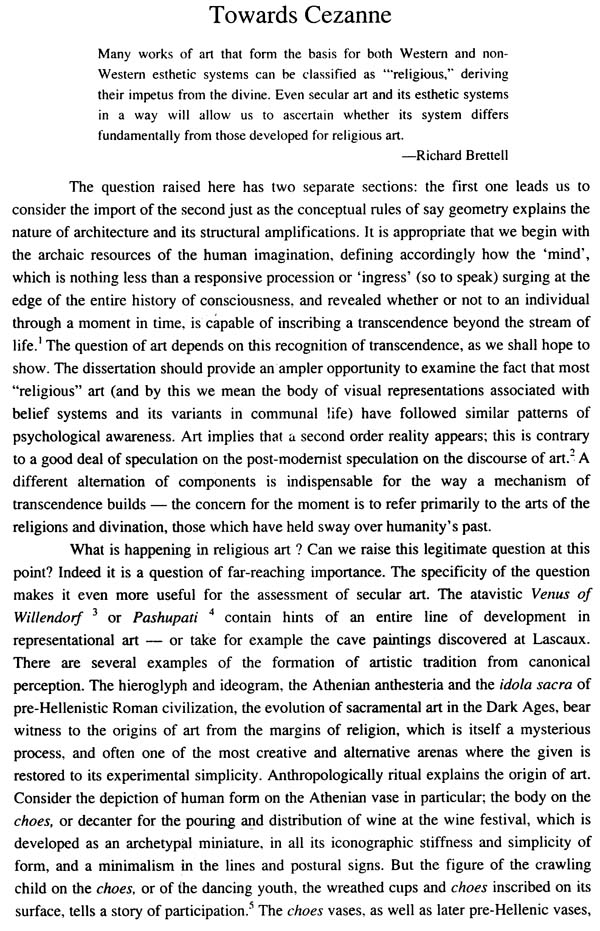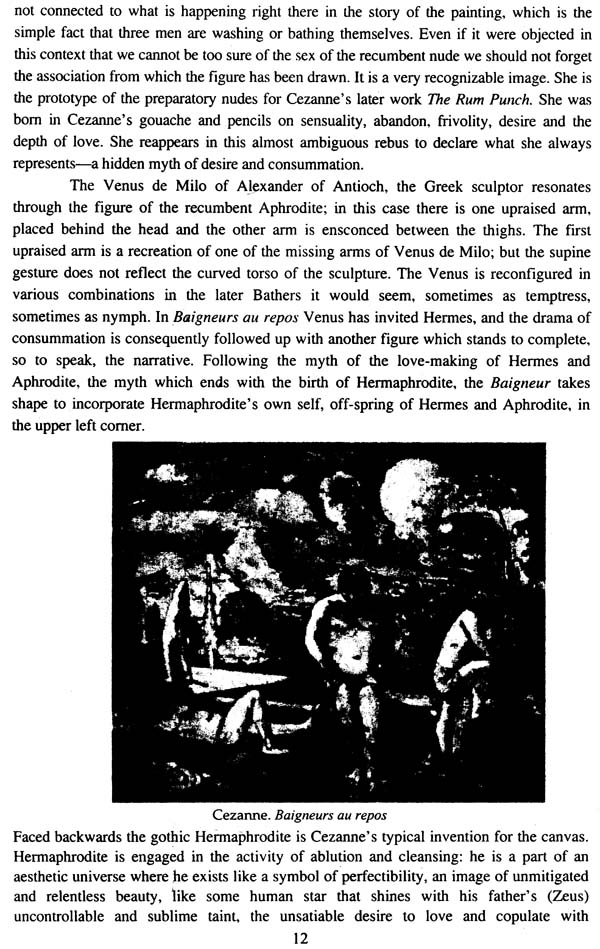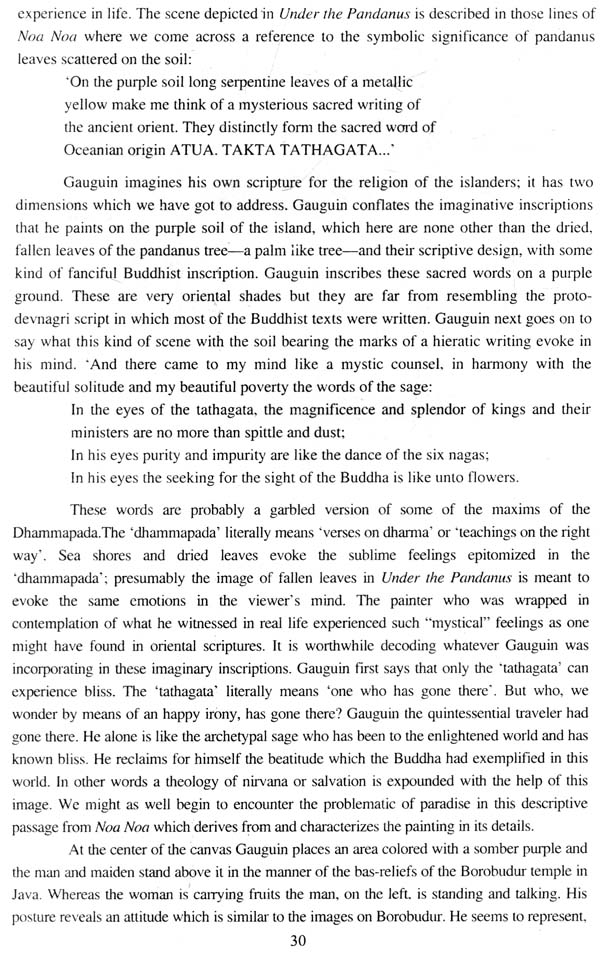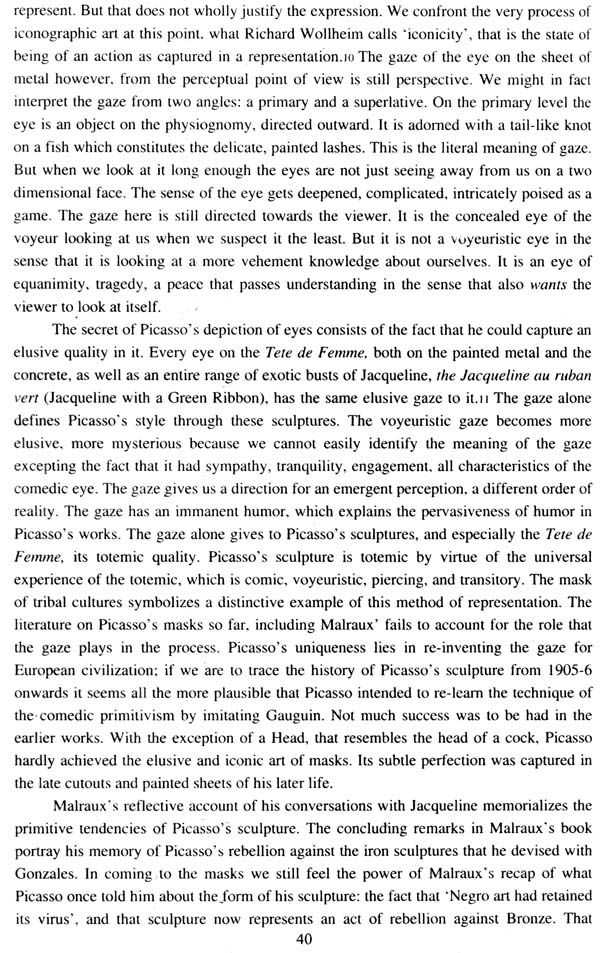
Cezanne to Picasso
Book Specification
| Item Code: | NAZ150 |
| Author: | Tirtha Prasad Mukhopadhyay |
| Publisher: | University of Calcutta |
| Language: | English |
| ISBN: | 9788192248103 |
| Pages: | 50 (Throughout B/w Illustrations) |
| Cover: | PAPERBACK |
| Other Details | 9.50 X 6.50 inch |
| Weight | 90 gm |
Book Description
Tirtha Prasad Mukhopadhyay is Associate Professor of English at the University of Calcutta. His major works include Non-Dualism and Other Essays (200 I). Affective States in Art (~005). Aesthetics: A Cognitive Viewpoint (20 II). His criticism of art and Bengali literature is included in the collection Sahitya. Sanskrit Darshan (Kolkata 2007).
The second reason is, in some ways, more important as we celebrate this important text. Professor Mukhopadhyay is emphatically NOT an art historian. Although he has taken graduate and perhaps even undergraduate classes in art history (some from me), he is actually a philosopher and aesthetician for whom art history is a source of necessary preliminary knowledge rather than the scholarly context for his inquiry. He has READ a good deal of art history-much of it with the same critical ease and distance that he applies to his close reading of works of art by Cezanne and others. He has also looked carefully at works of art. But, that said, he does both his reading and looking as a philosopher for whom the contribution of art to ideas is more important than its formal innovations or its role in the history of the society in which it is produced. For Professor Mukhopadhyay, the work of art communicates most powerfully outside the particular artistic and social context in which it was made. Although he is mindful of the power of that context and of the traditions of form-making that lie behind the works he discusses, it is actually the ways in which they surmount these defining issues that interests him.
Cezanne is one of the first great French modernists whose work was championed by non-French writers-and even by non-art historians. The names Edward Fry, Julius Meier-Graeme, Lionel Venturi, John Rewald, Kurt Bart, Wayne Anderson, Theodore Riff, Lawrence Gowing, Richard Shiff, or Walter Fei1chenfeldt are anything but French, but they are ALL German, British, Italian or American, but all of them are, in the end, art historians who consider Cezanne's art in the context of works of art produced by other artists in a continuum of formal and iconological achievement. Indeed, what is interesting when one thinks about the nationality of Cezanne's great interpreters is quite simply how few of them are--or were- French! It is almost as if Cezanne's creative swerving from the great traditions of French art were more readily understood by foreigners. Yet, how clear it is that art history- the discipline of humanistic study that emerged with the art museum and only gained its first maturity as the Impressionists and Post-Impressionists began their onslaught on tradition- has hijacked art, creating a supercharged abundance of texts that has succeeded more in warning others from attempting anything else than in providing a welcoming source of information for students of human imagination more broadly.
For Cezanne's oeuvre, the non-art-historian writer of the most commanding significance is the poet Rainer Maria Rilke, whose "Umber Zweig bilder von Paul Cezanne" was published posthumously in Die Kunst in October of 1938 and was followed by his magisterial Lettres sure Cezanne, published in Paris during the Second World War in 1944, nearly two decades after the poet's death in 1926. Rilke had written the letters to his wife about Cezanne's paintings in 1907, when he went obsessively to Cezanne exhibitions, starting with the great retrospective of that year. His interest in art was already well- established-he was the personal secretary of the great sculptor August Rodin at the time, but his interest in art was much broader than that of an art professional in early twentieth century France-whether a dealer, a collector, a critic, or a curator. For Rilke, these works of art communicated beyond the confines of the materials and beyond those of "painting" itself, with its own increasingly hermetic histories. This is the kind of writing that anticipates the present work.
Professor Mukhopadhyay, however, does more than write "letters to his wife," the form of which allows both greater flexibility and less intellectual pressure than do essays written to be published sequentially and to form a coherent series of arguments.
The latter is Professor Mukhopadhyay's ambition- and he succeeds at it to such an extent that Cezanne to Picasso well deserves to be included in any Cezanne bibliography.
When we compare it to the book about Cezanne by the businessman-collector, Albert Barnes, who self-published his first essay about Cezanne in 1925, the ambitions and rigor of Prof. Mukhopadhyay becomes clear. Whereas Barnes is obsessed with formal and compositional issues, reading each painting almost as if the represented subject was irrelevant, Mukhopadhyay homes in a handful of major works on which he lavishes his attentions in an unhurried marmel Not only does he deal with Cezanne's art in the context of global theories of religious art and of the artist's own fascination with classical and modem literature, but he also carefully measures the effect of Cezanne's aesthetic systems on the painting of major artists like Paul Gauguin, who predeceased Cezanne by three years, and the sculpture of Pablo Picasso, who outlived him by more than two generations.
Book's Contents and Sample Pages
